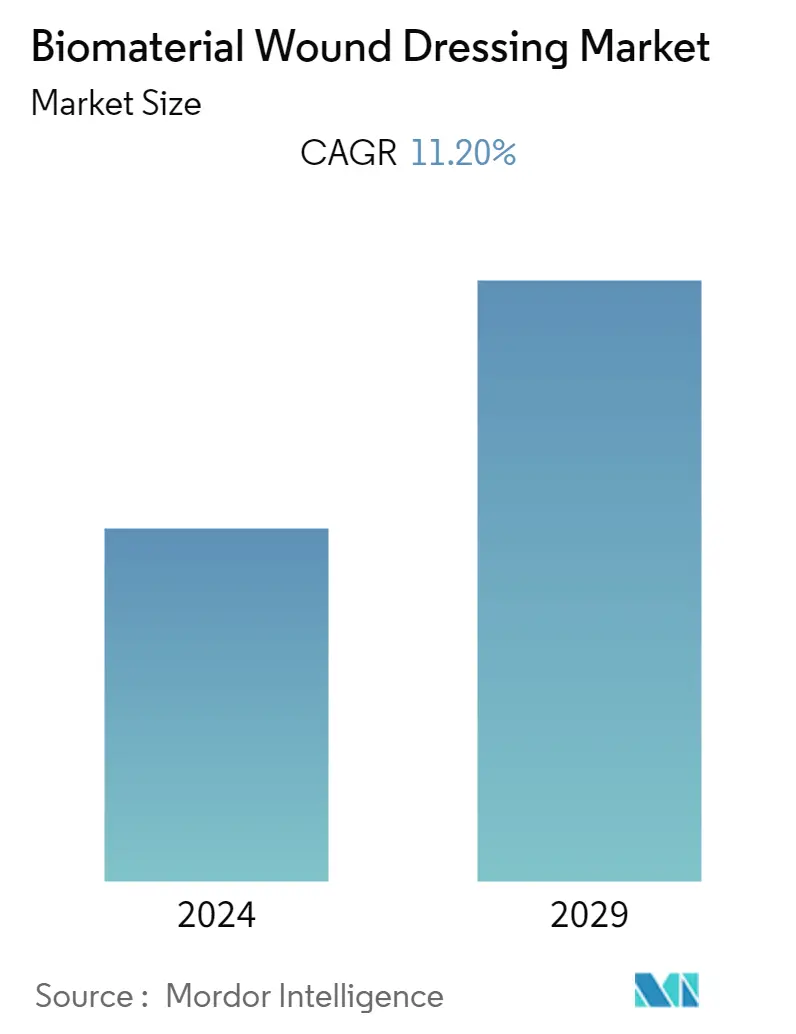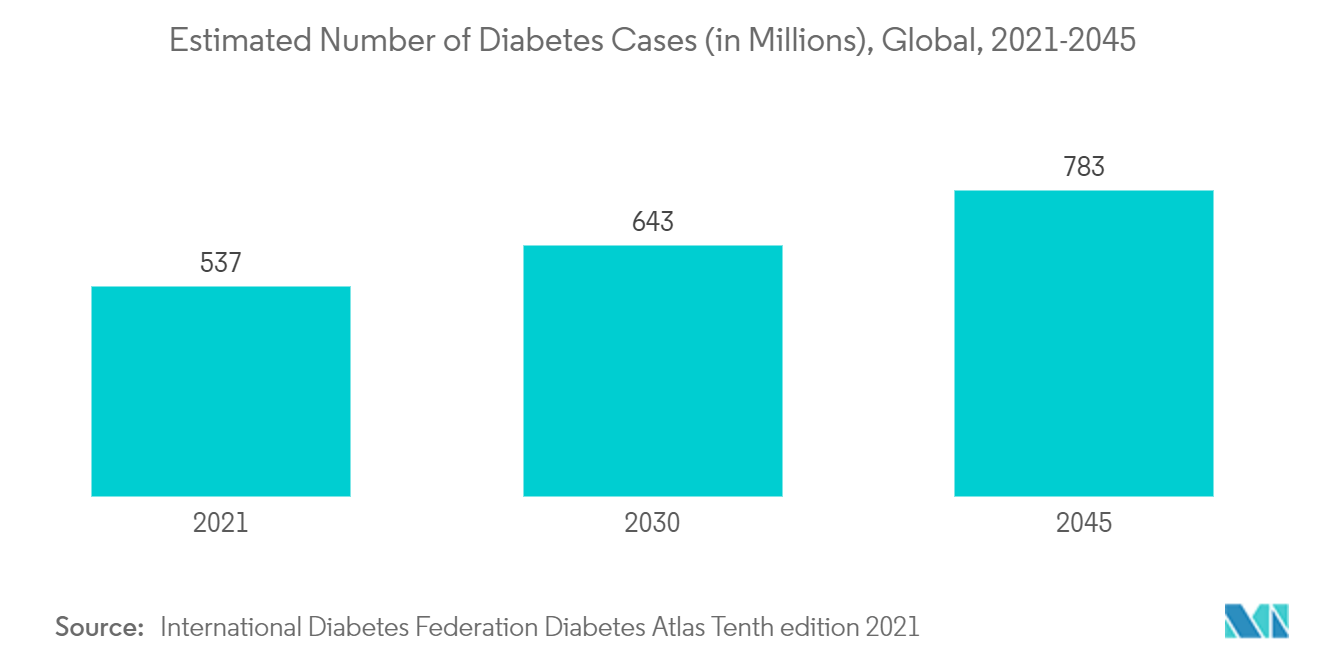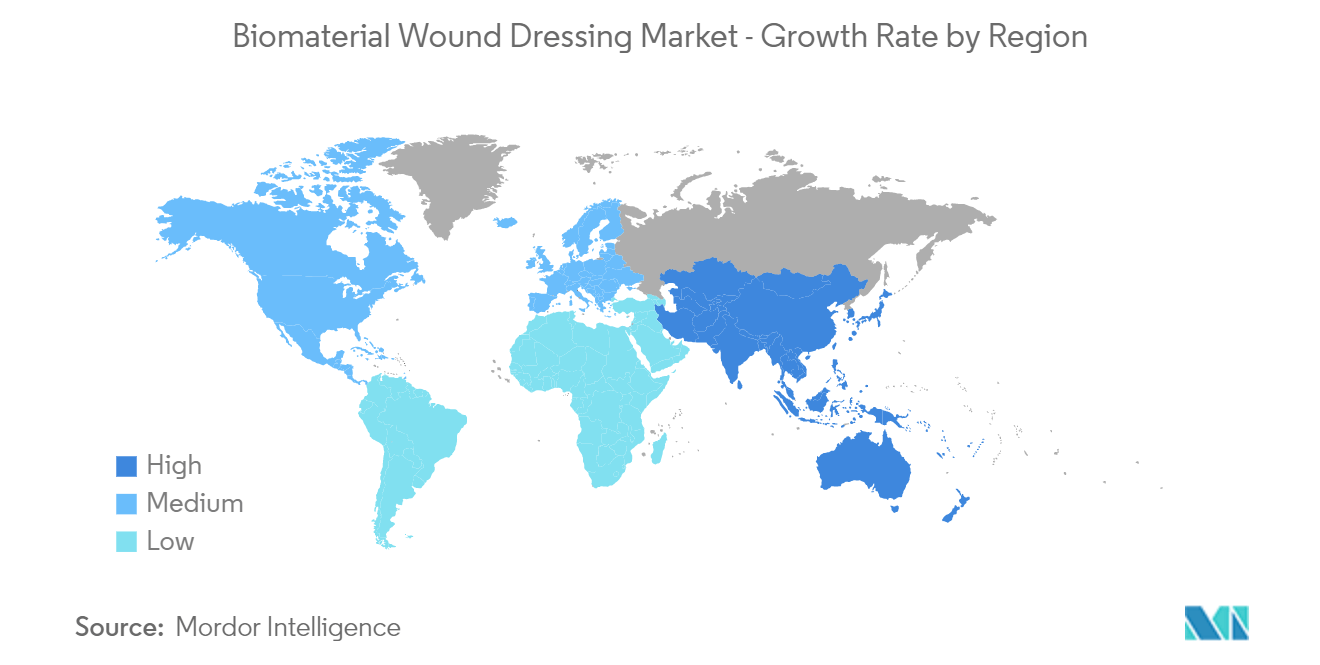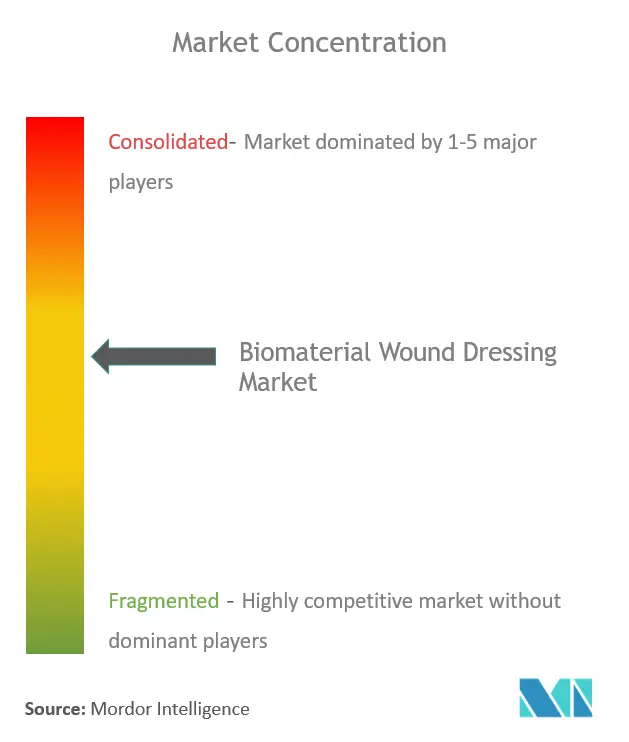Biomaterial Wound Dressing Market Size

| Study Period | 2021 - 2029 |
| Base Year For Estimation | 2023 |
| Forecast Data Period | 2024 - 2029 |
| CAGR | 11.20 % |
| Fastest Growing Market | Asia Pacific |
| Largest Market | North America |
Major Players
*Disclaimer: Major Players sorted in no particular order |
Biomaterial Wound Dressing Market Analysis
The biomaterial wound dressing market is expected to register a CAGR of 11.2% during the forecast period.
The COVID-19 pandemic severely affected the healthcare sector, including the biomaterial wound dressing segment. Moreover, the COVID-19 pandemic affected the global economy and showed a huge impact on the functioning of general hospital care for non-COVID-19 patients in hospitals globally. For instance, according to an article published by the AJMC in September 2021, a significant percentage of patients with chronic wounds had delayed preventative and emergent wound care during the COVID-19 pandemic. Such delays during the COVID-19 pandemic negatively impacted the growth of the studied market. However, with the restrictions being lifted, wound care services have been resumed, which is expected to add to the growth of the biomaterial wound dressing market over the forecast period.
The biomaterial wound dressing market is driven by advancements in technology, a growing ageing population, the rising burden of chronic wounds and problems, and side effects associated with conventional wound healing procedures. Furthermore, an increase in government initiatives, demand for fast and safe treatment for chronic wounds, and an increase in the prevalence of lifestyle disorders such as diabetes leading to venous leg ulcers, pressure ulcers, and diabetic foot ulcers propels the growth of the market. For instance, according to the International Diabetes Federation's IDF Diabetes Atlas Tenth edition 2021, over 537 million adults in the world were living with diabetes in the year 2021. The source also reported that the number of diabetic people in the world would increase to 643 million by 2030 and 783 million by 2045. The rising number of people affected by diabetes, who are more susceptible to foot ulcers is expected to boost the growth of the studied market.
The expansion of public health programs devoted to wound management is also anticipated to fuel market expansion. During a webinar hosted by the National Wound Care Strategy Programme in May 2022, for instance, presenters discussed a number of different approaches to healing venous leg ulcers. The expansion of the examined market is anticipated to benefit from initiatives aimed at raising public awareness of wound care services.
However, the high cost of treatment and unfavorable reimbursement policies are the few factors that hinder the market growth.
Biomaterial Wound Dressing Market Trends
This section covers the major market trends shaping the Biomaterial Wound Dressing Market according to our research experts:
Alginate Dressing is Anticipated Have Significant Share in the Forecast Period
Alginate dressing refers to light, non-woven natural wound dressings that are composed of highly absorbent materials and promote healing. These are widely used in exudent wounds, where there is excess fluid. Alginate dressing is usually made from seed wood thus, highly absorbent and providing a moist wound environment that is favorable for treating dry injuries.
Furthermore, alginate dressing is suitable to treat bleeding wounds and keep nerve endings moist reducing pain. This makes them preferable in treating heavily draining wounds, surgical wounds, first and second-degree burns, and in donor sites, this is likely to fuel the segment growth over the forecast period.
Alginate is widely used in wound healing properties owing to its hydrophilic nature. For instance, according to an article published in the journal of Personalized Medicine in September 2021, alginate is the most common biomaterial with wound-healing properties, when compared to other biomaterials. The alginate wound dressing can take up multiple forms such as beads, blends, dressings, electrospun scaffolds, flexible fibers, films, foams, gels, hydrogels, injections, microparticles, microspheres, nanoparticles, polyelectrolyte complex, powders, ropes, sheets, sponges, and others due to its hydrophilic nature, and are thus used on post-traumatic wounds or exuding wounds. Such wide application of the alginate dressing is expected to boost the growth of the studied segment over the forecast period.
Moreover, the research on the use of alginate dressing for chronic wound healing has also been on the rise in recent years. For example, an article published in F1000Res. in June 2021 indicated that gallic acid-incorporated alginate biofilm could be efficiently used for the treatment of low to medium-suppurating chronic wounds. Thus, the improved research on alginate dressings is expected to propel the growth of the market segment over the forecast period.

North America Expected to have Significant Market Share in the Forecast Period
North America's biomaterial wound dressing market is projected to have a significant market share worldwide. Major factors that are driving the market in the region are a rapidly growing aging population, a high diabetic population, and the developed healthcare system, which adapts to novel innovations.
The increasing number of people affected by diabetes is a major factor contributing to the market growth. For instance, according to the National Diabetes Statistics Report updated in January 2022, around 37.3 million people in the United States have diabetes, which equates to around 11.3% of the total population. Also, the report stated that around 96 million people aged 18 years or older in the United States have prediabetes. Moreover, as per the American Diabetes Association Statistics updated in February 2022, about 283,000 people in the United States under the age of 20 are estimated to have been diagnosed with diabetes, approximately 35% of that population.
Also, as per the International Diabetes Federation, in 2021, over 2.9 million people in Canada in the age group of 20-79 years were found to be affected by diabetes. The same source indicated that by 2040, the number of people with diabetes in the nation would rise up to around 3.5 million. The rising diabetic population in the North American region, who are more susceptible to foot ulcers, is expected to increase the demand for innovative wound dressing technologies, which is likely to add to the market growth over the forecast period.
Moreover, the presence of key market players coupled with their activity in the launching of new products and R&D are expected to bolster the market growth in the region.

Biomaterial Wound Dressing Industry Overview
The biomaterial wound dressing market is moderately fragmented and competitive. The major market players, such as 3M, ConvaTec Group PLC, Mölnlycke Health Care AB, Smith & Nephew PLC, and B. Braun Melsungen AG, hold a significant market share in the industry. Most of the market players are focusing on bringing advanced products in the market to acquire the maximum market share.
Biomaterial Wound Dressing Market Leaders
-
ConvaTec Group PLC
-
Smith & Nephew PLC
-
Mölnlycke Health Care AB
-
B. Braun Melsungen AG
-
3M
*Disclaimer: Major Players sorted in no particular order

Biomaterial Wound Dressing Market News
- June 2022 : Collagen Matrix, a United States-based regenerative medicine firm, received 510(k) clearance from the Food and Drug Administration for a new fibrillar collagen wound dressing, an absorbent microfibrillar matrix used to treat wounds.
- March 2022 : the Centre for Regenerative Medicine and Devices (CRMD) of the University of Brighton initiated a project, 'A biomimetic macromolecular platform for tissue healing and diagnostics at medical device interfaces: a personalised wound dressing model' to develop personalized smart dressings that stimulate tissue repair and report on the body's healing processes could transform wound treatment. The project is funded with USD 2.96 million by the Engineering and Physical Sciences Research Council.
Biomaterial Wound Dressing Market Report - Table of Contents
1. INTRODUCTION
- 1.1 Study Assumptions and Market Definition
- 1.2 Scope of the Study
2. RESEARCH METHODOLOGY
3. EXECUTIVE SUMMARY
4. MARKET DYNAMICS
- 4.1 Market Overview
-
4.2 Market Drivers
- 4.2.1 Growing Burden of Chronic Wounds and Associated Diseases
- 4.2.2 Government Initiatives Regarding Wound Care Treatment
-
4.3 Market Restraints
- 4.3.1 Lack of Proper Reimbursement
-
4.4 Porter's Five Force Analysis
- 4.4.1 Threat of New Entrants
- 4.4.2 Bargaining Power of Buyers/Consumers
- 4.4.3 Bargaining Power of Suppliers
- 4.4.4 Threat of Substitute Products
- 4.4.5 Intensity of Competitive Rivalry
5. MARKET SEGMENTATION (Market Size by Value - in USD Millions)
-
5.1 By Product
- 5.1.1 Hydrocolloids
- 5.1.2 Alginate Dressing
- 5.1.3 Skin Substitutes
- 5.1.4 Other Products
-
5.2 By Application
- 5.2.1 Wounds
- 5.2.2 Burns
- 5.2.3 Ulcers
- 5.2.4 Other Applications
-
5.3 Geography
- 5.3.1 North America
- 5.3.1.1 United States
- 5.3.1.2 Canada
- 5.3.1.3 Mexico
- 5.3.2 Europe
- 5.3.2.1 Germany
- 5.3.2.2 United Kingdom
- 5.3.2.3 France
- 5.3.2.4 Italy
- 5.3.2.5 Spain
- 5.3.2.6 Rest of Europe
- 5.3.3 Asia-Pacific
- 5.3.3.1 China
- 5.3.3.2 Japan
- 5.3.3.3 India
- 5.3.3.4 Australia
- 5.3.3.5 South Korea
- 5.3.3.6 Rest of Asia-Pacific
- 5.3.4 Middle-East and Africa
- 5.3.4.1 GCC
- 5.3.4.2 South Africa
- 5.3.4.3 Rest of Middle-East and Africa
- 5.3.5 South America
- 5.3.5.1 Brazil
- 5.3.5.2 Argentina
- 5.3.5.3 Rest of South America
6. COMPETITIVE LANDSCAPE
-
6.1 Company Profiles
- 6.1.1 3M
- 6.1.2 ConvaTec Group PLC
- 6.1.3 DermaRite Industries LLC
- 6.1.4 B. Braun Melsungen AG
- 6.1.5 Hollister Incorporated
- 6.1.6 Integra LifeSciences Holdings Corporation
- 6.1.7 Johnson & Johnson
- 6.1.8 Medtronic PLC
- 6.1.9 Molnlycke Health Care AB
- 6.1.10 Smith & Nephew PLC
- *List Not Exhaustive
7. MARKET OPPORTUNITIES AND FUTURE TRENDS
** Subject To AvailablityBiomaterial Wound Dressing Industry Segmentation
As per the scope of the report, the wound is a disruption of skin epithelial lining or mucosa which results in thermal or physical damage. Any biomaterial wound dressing is a substance that has been engineered to interact with biological systems for controlling and healing infections. The biomaterial wound dressing market is segmented by product (hydrocolloids, alginate dressing, skin substitutes, others), application (wounds, burns, ulcers, and others), and geography (North America, Europe, Asia-Pacific, Middle East and Africa, and South America). The market report also covers the estimated market sizes and trends of 17 countries across major regions globally. The report offers the value (in USD million) for the above segments.
| By Product | Hydrocolloids | |
| Alginate Dressing | ||
| Skin Substitutes | ||
| Other Products | ||
| By Application | Wounds | |
| Burns | ||
| Ulcers | ||
| Other Applications | ||
| Geography | North America | United States |
| Canada | ||
| Mexico | ||
| Geography | Europe | Germany |
| United Kingdom | ||
| France | ||
| Italy | ||
| Spain | ||
| Rest of Europe | ||
| Geography | Asia-Pacific | China |
| Japan | ||
| India | ||
| Australia | ||
| South Korea | ||
| Rest of Asia-Pacific | ||
| Geography | Middle-East and Africa | GCC |
| South Africa | ||
| Rest of Middle-East and Africa | ||
| Geography | South America | Brazil |
| Argentina | ||
| Rest of South America |
Biomaterial Wound Dressing Market Research FAQs
What is the current Biomaterial Wound Dressing Market size?
The Biomaterial Wound Dressing Market is projected to register a CAGR of 11.20% during the forecast period (2024-2029)
Who are the key players in Biomaterial Wound Dressing Market?
ConvaTec Group PLC, Smith & Nephew PLC, Mölnlycke Health Care AB, B. Braun Melsungen AG and 3M are the major companies operating in the Biomaterial Wound Dressing Market.
Which is the fastest growing region in Biomaterial Wound Dressing Market?
Asia Pacific is estimated to grow at the highest CAGR over the forecast period (2024-2029).
Which region has the biggest share in Biomaterial Wound Dressing Market?
In 2024, the North America accounts for the largest market share in Biomaterial Wound Dressing Market.
What years does this Biomaterial Wound Dressing Market cover?
The report covers the Biomaterial Wound Dressing Market historical market size for years: 2021, 2022 and 2023. The report also forecasts the Biomaterial Wound Dressing Market size for years: 2024, 2025, 2026, 2027, 2028 and 2029.
Biomaterial Wound Dressing Industry Report
Statistics for the 2024 Biomaterial Wound Dressing market share, size and revenue growth rate, created by Mordor Intelligence™ Industry Reports. Biomaterial Wound Dressing analysis includes a market forecast outlook 2029 and historical overview. Get a sample of this industry analysis as a free report PDF download.



